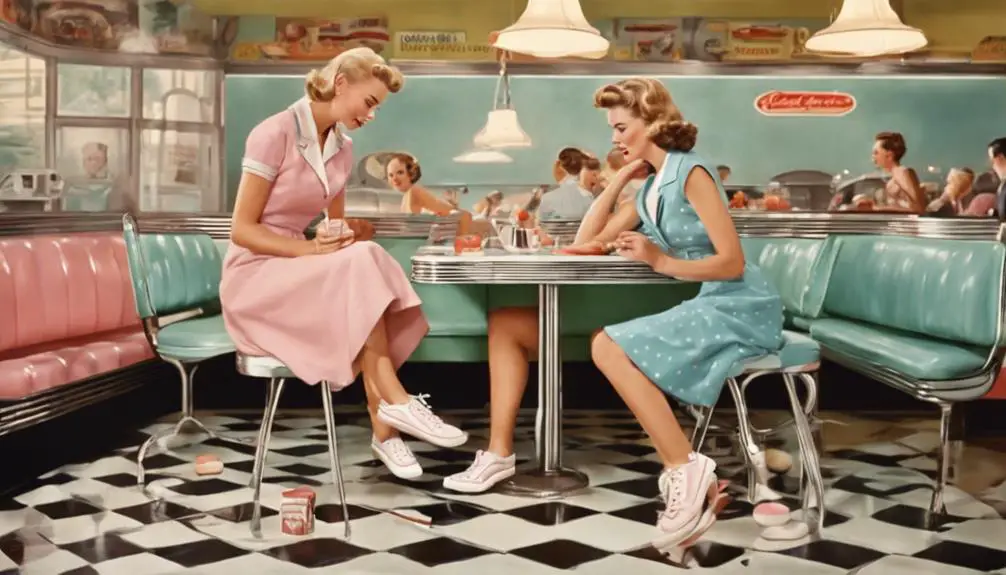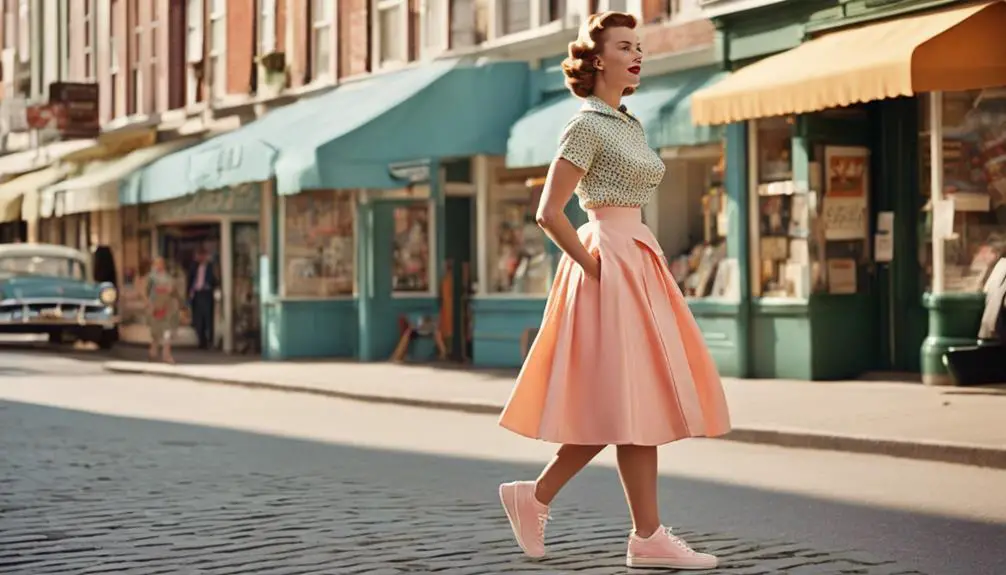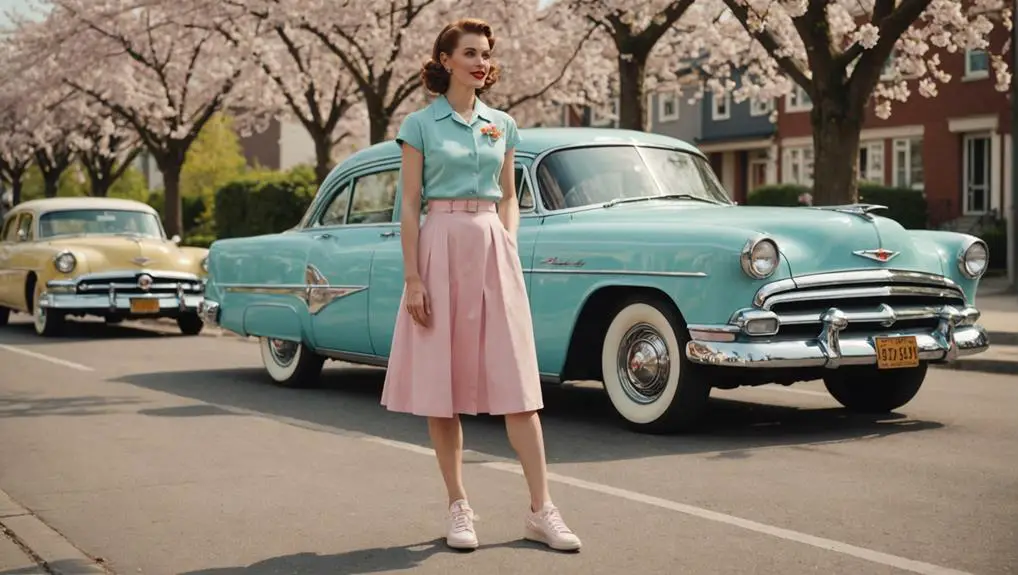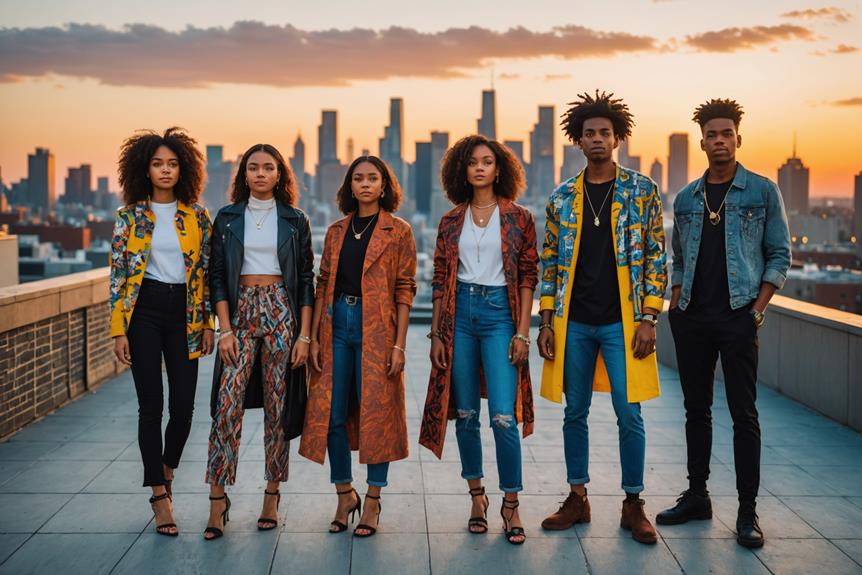In the 1950s, women's trainers revolutionized fashion, merging comfort with style. You'd find lightweight canvas designs and durable rubber soles, making trainers versatile for both sports and daily life. Brands like Keds dominated with their iconic two-tone styles, allowing for self-expression amid relaxed fashion trends. The era's cultural shift embraced trainers as a rebellion against formal wear, reflecting a more casual, youthful attitude. As women paired trainers with everything from denim to skirts, this footwear became a symbol of newfound freedom and practicality. Explore how these trends set the stage for modern styles and ongoing fashion influences.
Evolution of Women's Trainers

The evolution of women's trainers in the 1950s marked a significant change in both fashion and functionality, reflecting broader societal changes. As leisure activities gained popularity, trainers became more than just sports footwear; they evolved into a versatile option for everyday wear. You'd notice styles like Keds and Plimsolls, which featured lightweight canvas designs and rubber soles, embodying comfort and flexibility. This change allowed women and girls to enjoy a wide range of activities without sacrificing style.
The introduction of two-tone trainers further enhanced their appeal, allowing wearers to express their individuality. Trainers transformed from mere house shoes to fashionable casual wear, aligning with the decade's trend toward relaxed styles in women's fashion. As trainers gained traction, they effectively bridged the gap between athleticism and everyday life, catering to a growing desire for practicality without compromising aesthetics.
Key Features and Materials
Women's trainers in the 1950s showcased a combination of practicality and style, with key features that catered to the active lifestyle emerging during the decade. The use of canvas uppers became a defining characteristic, offering breathability and lightweight comfort—ideal for both casual outings and athletic activities. Popular styles like Keds and Plimsolls exemplified this trend, featuring simple designs that appealed to the youth culture of the time.
The rubber soles were another essential element, providing durability and flexibility. This made the trainers suitable for a variety of activities, from sports to everyday wear. The rubber's traction guaranteed you could navigate different surfaces without slipping, enhancing the shoe's functionality.
Moreover, trainers typically embraced low-profile designs with minimal cushioning, aligning with the era's focus on practicality. This design choice not only contributed to a sleek aesthetic but also allowed for better ground feel during movement. Many trainers were further adorned with colorful patterns and designs, reflecting the vibrant fashion trends of the 1950s, making them not just functional but also a stylish statement. Overall, these features combined to create a versatile footwear option that captured the spirit of the decade.
Cultural Impact on Footwear

During the 1950s, trainers stepped into the spotlight as a cultural phenomenon, reflecting the shifting attitudes of a generation enthusiastic to break free from traditional norms. The rise of youth culture meant that casual footwear like trainers became a canvas for self-expression, contrasting sharply with the brown leather shoes and high heels favored by their parents. Embracing comfort and sporty aesthetics, trainers emerged as symbols of rebellion.
Here are three key factors illustrating their cultural impact:
- Rebellion Against Formality: Trainers like Keds and Plimsolls represented a break from the rigidity of previous fashion standards, allowing teenagers to embrace individuality.
- Economic Prosperity: Post-war affluence enabled greater experimentation in fashion, leading to the mainstream acceptance of casual styles in everyday wear.
- Celebrity Influence: Hollywood icons sporting trainers contributed to their popularity, making them an essential part of many wardrobes.
As dance culture flourished, trainers with low heels became essential for active lifestyles, offering the flexibility needed for social events. This shift not only transformed footwear choices but also marked a significant cultural change in the 1950s.
Popular Brands and Styles
Amidst the vibrant backdrop of 1950s fashion, popular brands like Keds and Plimsolls captured the essence of a generation keen for change. Keds, with their iconic canvas design and rubber soles, quickly became a staple for everyday wear and athletic activities. You'd find young women slipping into these comfortable trainers, appreciating their versatility that seamlessly complemented casual outfits.
Plimsolls, originally crafted for sports, evolved into a fashionable choice as well, available in a myriad of colors and patterns. They resonated with the era's relaxed style, making them a favorite among teenagers eager to showcase their individuality. As youth culture flourished, trainers transformed into statement pieces, with women opting for vibrant hues to express their personalities.
These trainers were often paired with denim, skirts, and casual dresses, further solidifying their role in 1950s fashion trends. The combination of Keds and Plimsolls not only highlighted a shift towards more casual, comfortable footwear but also reflected a broader cultural movement towards self-expression and youthful rebellion. In this context, trainers became more than just footwear; they symbolized a new attitude toward style and identity in the post-war era.
Modern Interpretations and Trends

As the nostalgic influence of 1950s trainers continues to resonate in today's fashion landscape, modern interpretations bring fresh energy to these classic designs. You'll find that brands like Keds and Converse have revived the spirit of the era, offering vibrant, playful styles reminiscent of the originals. Here are three key trends to contemplate:
- Vintage-inspired Silhouettes: Many trainers today retain the classic low-top design while incorporating bold colorways and patterns that pay homage to the 1950s aesthetic.
- Sustainable Materials: Current styles often feature advanced cushioning technology and eco-friendly fabrics, merging vintage allure with contemporary values.
- Athleisure Influence: The rise of athleisure has made 1950s trainers a go-to choice for stylish comfort, positioning them as versatile footwear for everyday wear.
While peep toe and heel shoes remain popular, trainers embody a relaxed yet chic vibe that resonates with modern consumers. By blending retro elements with innovative features, today's trainers not only celebrate the past but also cater to the dynamic needs of current fashion enthusiasts.
Frequently Asked Questions
What Women's Shoes Were Popular in the 50s?
In the 50s, you'd see women sporting saddle shoes, ballet flats, and loafers. Sandals gained popularity too, reflecting a shift toward casual styles. Each option showcased unique designs, catering to various occasions and personal preferences.
Did They Have Sneakers in the 50s?
Yes, sneakers were indeed prevalent in the 50s. You'd find canvas designs with rubber soles, embraced by youth culture. They became essential for leisure activities, reflecting the era's growing fascination with casual and sporty aesthetics.
What Are the Black and White Shoes From the 50S Called?
The black and white shoes from the 1950s are called saddle shoes. They feature a distinctive contrasting design and were popular among teens, symbolizing youthful rebellion and a casual, sporty style during that era.
Were Mary Janes Popular in the 50s?
Yes, Mary Janes were incredibly popular in the 1950s. Their rounded toes and stylish straps made them a fashionable choice for young girls, often paired with dresses, embodying the decade's youth culture and vibrant fashion trends.





You made some decent points there. I looked on the web for the issue and located most people will associate with along with your website.
glad to be one of many visitants on this awful internet site : D.